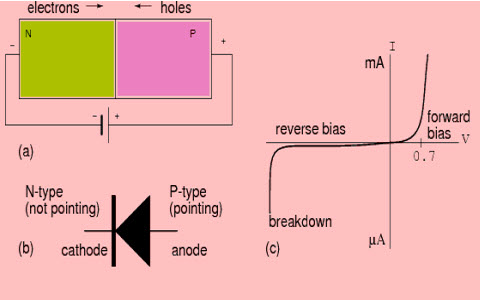Theory of P-N junction diodes
DIODE
A diode is a two terminal electric component that conducts current only in one direction. It has very low resistance(ideally zero) in one direction and very high(ideally infinite) in other direction.The function of a diode is to allow the current to flow only in one direction(forward direction),while blocking the flow in other direction(reverse direction).
P-N junction diode-
A P-N junction diode is a type of diode that is formed by doping one side of silicon by P-type(has holes) and the other by n-type(has electrons).Types of biasing in P-N Junction diode
There are three types of biasing for a P-N junction diode-Zero bias
No voltage is applied across the diode, and therefore, the holes from the p-region starts diffusing towards the n-region and the electrons from the n-region diffuses toward p-region.This generates an electric field which prevents further diffusion and so there is no movement in the middle region.This region is known as depletion layer.Forward Bias
In this case, the negative terminal of the battery is connected to the n-type terminal and the positive is connected to the p-type terminal of the diode. By this, the electrons and holes get enough energy to overcome the barrier potential(depletion layer) and cross the junction.Reverse bias
In this case, the n-type material is connected with positive terminal of the battery and the negative terminal is connected to the p-type material. By this, the electrons from the n-type material is attracted toward the positive terminal and the holes from the p-type material are attracted towards the negative terminal.This leads to the increase in width of the depletion layer.Due to the diffusive flow of minority electrons in p-type to n-type and the minority holes from the n-type to p-type a very small current flows through the diode, usually in nano amperes.








No comments